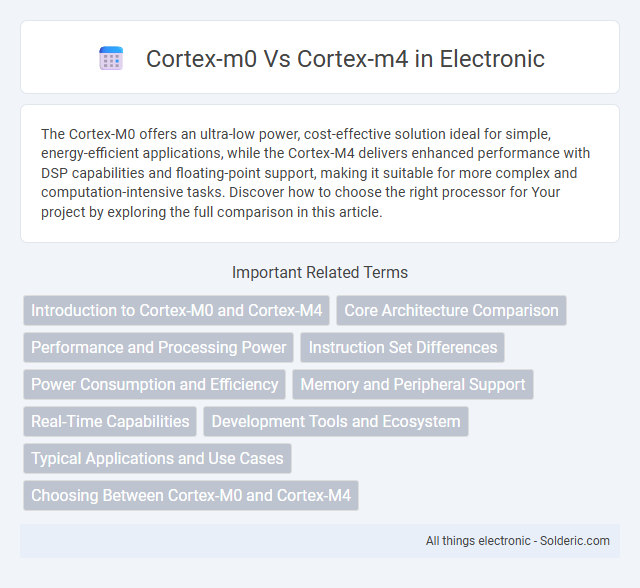The Cortex-M0 offers an ultra-low power, cost-effective solution ideal for simple, energy-efficient applications, while the Cortex-M4 delivers enhanced performance with DSP capabilities and floating-point support, making it suitable for more complex and computation-intensive tasks. Discover how to choose the right processor for Your project by exploring the full comparison in this article.
Comparison Table
| Feature | Cortex-M0 | Cortex-M4 |
|---|---|---|
| Architecture | ARMv6-M | ARMv7E-M |
| Performance | Up to 48 MHz | Up to 120+ MHz |
| Core Type | 2-stage pipeline | 3-stage pipeline with Floating Point Unit (FPU) |
| Instruction Set | Thumb-1 | Thumb-2 with DSP instructions |
| DSP Extensions | No | Yes |
| Floating Point Unit (FPU) | No | Single-precision FPU |
| Power Efficiency | Very low power, best for simple tasks | Low power with higher performance capabilities |
| Interrupts | Up to 32 interrupts | Up to 240 interrupts, Nested Vectored Interrupt Controller (NVIC) |
| Applications | Basic embedded systems, simple IoT devices | Advanced control, DSP, and signal processing applications |
Introduction to Cortex-M0 and Cortex-M4
Cortex-M0 is an ultra-low power, high-efficiency 32-bit processor optimized for simple, cost-sensitive embedded applications, while Cortex-M4 enhances performance with a digital signal processing (DSP) extension and optional floating-point unit (FPU) for more complex, real-time tasks. Your choice between the Cortex-M0 and Cortex-M4 impacts processing power, energy consumption, and application complexity, as the M4 offers higher clock speeds and advanced computational capabilities. Both cores support ARMv7-M architecture but cater to different markets: M0 for basic IoT devices and wearables, and M4 for motor control, audio processing, and industrial automation.
Core Architecture Comparison
The Cortex-M0 features a 32-bit ARMv6-M core with a simplified architecture optimized for low power and cost-sensitive applications, offering basic DSP instructions and Thumb instruction set. In contrast, the Cortex-M4 utilizes a more advanced ARMv7-M core that includes a hardware Floating Point Unit (FPU) and enhanced digital signal processing capabilities, supporting single-cycle multiply and divide operations. The Cortex-M4's architecture enables higher performance, more efficient interrupt handling, and better real-time control, making it suitable for more complex embedded systems compared to the Cortex-M0.
Performance and Processing Power
The Cortex-M4 offers significantly higher processing power compared to the Cortex-M0, featuring a 32-bit RISC architecture with DSP instructions and optional floating-point unit (FPU) that enable faster and more efficient handling of complex algorithms. You gain superior performance with clock speeds up to 100 MHz or more, while the Cortex-M0 typically runs at lower frequencies around 48 MHz, optimized for ultra-low-power applications. This performance gap makes the Cortex-M4 ideal for digital signal processing, motor control, and advanced embedded systems requiring robust computational capabilities.
Instruction Set Differences
The Cortex-M0 uses the ARMv6-M instruction set optimized for ultra-low power and minimal code size, while the Cortex-M4 implements the more advanced ARMv7E-M instruction set, supporting DSP and SIMD instructions for enhanced performance. Your application requiring digital signal processing or complex arithmetic will benefit from the M4's enriched instruction set architecture. The M4 also supports hardware multiplication and division instructions absent in the M0, improving computational efficiency.
Power Consumption and Efficiency
The Cortex-M0 delivers exceptional power efficiency, optimized for ultra-low power applications with minimal energy consumption during active and sleep modes. The Cortex-M4, featuring DSP extensions and a more powerful core, consumes more power but offers higher processing capabilities for complex signal processing tasks. Your choice depends on balancing power consumption and computational efficiency based on application requirements.
Memory and Peripheral Support
The Cortex-M4 processor supports larger memory sizes and offers more advanced memory protection units (MPU) compared to the Cortex-M0, which is limited to simpler memory maps and smaller addressable memory space. Peripheral support on the Cortex-M4 includes enhanced digital signal processing (DSP) blocks and floating-point units (FPU), allowing for more complex and efficient handling of peripherals such as PWM, ADC, and communication interfaces. In contrast, the Cortex-M0 provides basic peripheral support ideal for low-power applications with simpler I/O requirements and minimal DSP capabilities.
Real-Time Capabilities
The Cortex-M4 core offers significantly enhanced real-time capabilities compared to the Cortex-M0, featuring a higher clock speed and advanced interrupt handling with tail-chaining and late arrival features, which reduce latency and improve response times. It supports a more efficient nested vectored interrupt controller (NVIC) that ensures rapid context switching, crucial for time-sensitive applications. Your choice between these cores depends on the real-time processing demands of your project, with the M4 providing superior performance for complex real-time control tasks.
Development Tools and Ecosystem
Cortex-M0 and Cortex-M4 microcontrollers benefit from extensive development tools and ecosystems, including IDEs like Keil MDK and IAR Embedded Workbench that support both cores. The Cortex-M4 offers advanced DSP and FPU capabilities, attracting more specialized software libraries and middleware for signal processing and real-time control applications. Your choice might depend on the availability of debugging tools, third-party components, and community support tailored to the complexity of your embedded project.
Typical Applications and Use Cases
The Cortex-M0 is ideal for ultra-low-power applications such as wearable devices, basic IoT sensors, and simple home automation systems due to its minimal energy consumption and cost-effective design. The Cortex-M4, featuring DSP instructions and floating-point unit, excels in more demanding embedded systems including motor control, digital audio processing, and advanced IoT applications requiring real-time signal processing and higher computational capabilities. Both processors cater to embedded systems but differ significantly in application complexity and performance needs.
Choosing Between Cortex-M0 and Cortex-M4
Choosing between Cortex-M0 and Cortex-M4 depends on application requirements; Cortex-M0 offers low power consumption and minimal silicon area, ideal for simple, cost-sensitive projects. Cortex-M4 provides higher performance with a 32-bit processor, DSP instructions, and optional floating-point unit, suited for real-time control and complex signal processing tasks. Evaluate power efficiency, processing speed, and peripheral needs to match the microcontroller core to project goals.
cortex-m0 vs cortex-m4 Infographic

 solderic.com
solderic.com